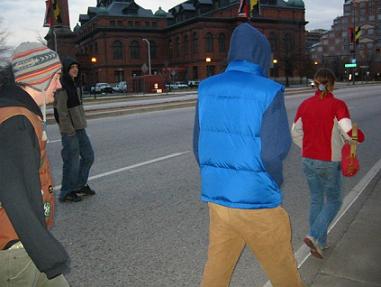I have successfully acquired the signature of the Fencing professor and am now in the McDaniel computer lab with an hour to spare before my next class (Shakespeare). I could go listen to the news podcasts I downloaded this morning or read the feminist theory book a prof lent me (actually way more interesting than it sounds), but instead I shall tell you about my trip to Baltimore yesterday. But first, I’ll show you.

That’s Connor, Gabe, Ben, and Cassandra. Missing from the picture are Jancey and Julia.
Anyway, we went to Baltimore yesterday to visit the American Visionary Art Museum. My parents go there occasionally, so I’d heard of it, and even quite a bit about it, but I’d never been myself. There was a big part of me that would have preferred to sleep through the afternoon, but the sister convinced me it would be worth it, and so we embarked.
It was worth it, no question. The range of quality is greater than in most museums I’ve visited, but the cool stuff is *really* cool, and there’s a fair amount that’s cool in a mind bogglingly absurd kind of way. Like the 16 foot model of the Lusitania made entirely out of toothpicks. Or the matchstick man, whose creator said things like, “Each matchstick represents a human being.” There is something beautiful about that idea, but it’s not your typical art museum fare.
My favorite piece was a seven panel painting by James Franklin Snodgrass which, from a distance, looks like two (very abstract) reclining figures, and from less of a distance can be seen to be comprised of zillions of tiny detailed smaller figures. Some of them are just faces and bodies floating there, but others are doing things, like bathing, drowning, assembling in groups, etc. I could get lost in it for days, I think, but I’m not sure I’d come back with my sanity intact. Unfortunately, there don’t seem to be any pictures of the piece on the net (not that it could even come close to capturing the awesomeness). So you should go and check it out for yourself.
All of the art I mentioned above is in the museum’s permanent collection; the current exhibit is “Race, Class, Gender ≠Character”. Some of the exhibit was excellent, some was mediocre, and some was…eh. It’s accompanied by some interesting text, but you can read all of that on the exhibit’s website. It’s certainly worth visiting, though, if only to see some of the interesting things people are doing — like phenomenally intricate pictures from cutting and pasting colored papers, or the hundreds of dolls made from pipe cleaners. Also, some work by Rosie O’Donnell. I didn’t know she was an artist.
The current exhibit is there until September 3, 2006, but the Snodgrass painting is there all the time and it alone is probably worth the price of admission.
